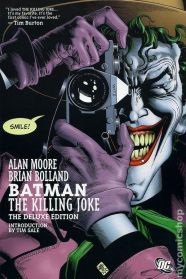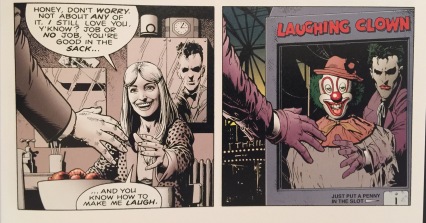
My rating: ★★★★☆
*Warning this post contains storyline spoilers*
The Basics: In one of the most famous Batman graphic novels, which navigates around a twisted past, the Joker launches perhaps his sickest scheme yet to prove to Gotham that even the sanest are just “one bad day” away from his world of madness.
In-depth: To feel the part in New York City last October I equipped myself with a New Yorker Magazine for a princely $8. In the Goings On About Town section I noticed an exhibition entitled ‘Superheros in Gotham’ at the New York Historical Society. Caught up in my moment of serendipity I convinced my friends to give it a try (it didn’t take much) and we walked through Central Park to the Society.
Unfortunately the exhibition wasn’t as good as we were hoping. It was frightfully small with a no photography policy strictly enforced by over keen security guards. The one highlight was seeing the actual Batmobile from the original Batman TV show. Walking back slightly disappointed I spotted some impromptu book stands where I came across The Killing Joke. My mood improved as soon as I started reading it.
At just 46 pages it did not take long and having recently re-read it I decided to review it on this blog. Admittedly it is the first graphic novel I’ve read and it was the perfect choice. “One of the greatest Batman stories” the friendly guy at the stall told me and he was 100% right.
The story is beautifully simple and as quick as it is intense. It centres around perhaps the Joker’s most disturbing scheme. To prove that Gotham can not and should not maintain it’s perverse commitment to law, order and indeed sanity by targeting it’s leading light Commissioner Jim Gordon and by doing this thereby drawing out his arch nemesis: the Batman.
The recently escaped Joker intends to prove a point by driving Gordon mad and show the world that “all it takes is one bad day to reduce the sanest man alive to lunacy.” It is some bad day for Gordon as the Joker ambushes and shoots his daughter Barbara before his very eyes. Putting a bullet through her spine and having his goons kidnap the distraught Gordon, the Joker then completes what he thinks will be his coup de grâce by undressing the wounded Barbara and photographing her in lurid positions mercifully mostly left to the reader’s imagination by the artist Brian Bolland. It is no surprise that this passage, particularly the use of Barbara as merely a prop to get at her father, caused such a storm after many feminist readers were aghast at its overtly sexist nature.
Having the beaten and stripped Gordon paraded around his new recently acquired fairground, the Joker explains to him his simple choice. He can either suffer the trauma of his memories which through his rationality he still clings to, or choosing the ’emergency exit’ of insanity, flee into the freedom of the chaos which forms the basis of the Joker’s existence and Gotham’s unjust world.
What perhaps makes this novel so famous is it’s revealing of the Joker’s past. Before becoming the Clown Prince of Crime it depicts his failed attempts at being a stand up comedian as well as the crippling anxieties of his fear of failing to support his pregnant wife. That Alan Moore and Bolland are able to present this so deeply in such short spaces shows the intelligence and skill which lies behind every word and sketch in the Killing Joke.
One of my favourite frames is the jump between a tragic past as a failed comedian and husband to the Joker’s scheming at his violently acquired fairground. The (almost)

The lack of colour in the scenes from the Joker’s past is also significant. Bolland brilliantly chooses single objects to possess the increasingly rageful red which builds up via fly-trapping sticky tape, shrimps and the red-hood worn during the botched robbery where the scared predecessor to the Joker flees the Batman only to fall into a vat of chemicals which produces the Clown Prince of Crime.
The scenes from the past are also deliciously mixed up by the Joker himself, who confused by the madness which now inhibits him, reels off the various other possible personal histories of what sent him over the edge. Such as his wife being murdered by the Mob (in this she supposedly dies in a once in a million electrical accident) or his brother being carved up by a knife welding mugger. This cleverly buys into the wealth of speculative interpretations which exist about the Joker’s past.
Back to the present and after mentally torturing Gordon and believing he has indeed driven the Commissioner mad the Joker gets what he really wants; the arrival of the Batman. After a desperate fight which involves trap doors to doom, knifes, a hall of mirrors and a pretend pistol the Batman eventually wrestles the Joker under his control.
Pleading with him to not continue their duel down the route which will only lead to one of them dying, Batman attempts to reach out to the Joker, briefly hinting at his own knowledge of suffering due to a tragic past, by offering him rehabilitation.
The Joker’s response is, as ever, a joke. Significantly it is about two men trying to escape a lunatic asylum where one offers the other an escape over a bridge of torch light. The joke being you’d have to be crazy to trust the other prisoner to keep the torch on, as oppose to believing you can walk on light.
The Batman then grabs the Joker with the light of the approaching police cars visible. The Joker’s laughter, then uncharacteristicily joined by the Batman’s, fills the night and the final two panels offering an almost completed bridge of light which in the next panel disappears into darkness. Some have interpreted this as the Batman finally killing the Joker, the incessant laughter does suddenly stop, but this is wonderfully left to the interpretation and imagination of the reader.

The ending is incredible. It just shows one beam of light, like Joker’s joke, and then it gets turned off. Is it implying Batman finally did the inevitable, and ended the Joker’s life? That’s for the reader to interpret.
LikeLiked by 1 person
Wow that’s ace. I didn’t pick up on that at first. Thanks for the comment. Have adapted the end of my review to reflect that interpretation.
LikeLiked by 1 person
It’s a tough interpretation to make in the end. It can be seen as Batman killing the Joker, but I also see another side of it: the Joker wins. Batman has snapped. The (s)cowl is gone, replaced by laughter. One bad day, that’s all it takes according to the Joker. And if Batman does kill the Joker… then the Joker’s won.
It’s a very good graphic novel. In a much longer format but still by Alan Moore, I would definitely recommend Watchmen if you haven’t read it yet.
LikeLike
I tagged you for the Inside Out Book Tag! Sorry for the late comment 🙂 https://thebooksareeverywhere.wordpress.com/2016/02/27/book-tag-the-inside-out-book-tag/
LikeLike
That sounds completely amazing, I have to read it!
LikeLiked by 1 person
Check out my blog at https://readersofthelostarc.wordpress.com
LikeLiked by 1 person
I loved the graphic novel. Probably my favorite. I really want to see this movie.
LikeLike